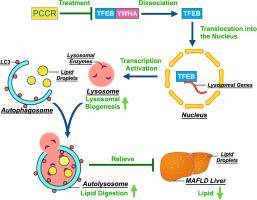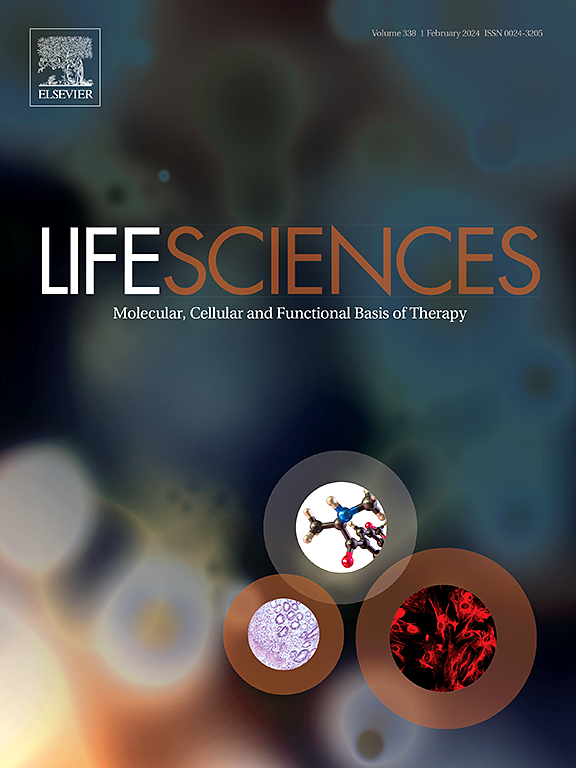Polygoni Cuspidati Rhizoma et Radix extract activates TFEB and alleviates hepatic steatosis by promoting autophagy
IF 5.2
2区 医学
Q1 MEDICINE, RESEARCH & EXPERIMENTAL
引用次数: 0
Abstract
Hepatic steatosis, characterized by excessive lipid accumulation in the liver, can be ameliorated by autophagy activation. Polygoni Cuspidati rhizome et Radix (PCRR), traditionally used to treat atherosclerosis, hepatitis, and gallstones, has recently demonstrated anti-steatotic effects in the liver. However, the active compounds and underlying mechanisms remain unclear. This study investigated whether PCRR water extract improves steatosis by modulating hepatic autophagic flux. We found that PCRR water extract promoted autophagic flux, enhanced lysosomal biogenesis, and alleviated lipid accumulation in the liver cell lines as well as in the livers of rats with steatosis. Mechanistically, PCRR water extract inhibited mechanistic target of rapamycin complex 1 (mTORC1) activity, leading to dephosphorylation and subsequent nuclear translocation of transcription factor EB (TFEB), a key regulator of lipophagy. TFEB knockdown attenuated PCRR-mediated lipophagy promotion in the liver cell lines. Furthermore, chloroquine (CQ)-mediated autophagy blockage abrogated the therapeutic effect of PCRR against hepatic steatosis in high-fat diet (HFD)-fed rats. These findings suggest that PCRR water extract acts as a novel autophagy enhancer and holds therapeutic potential for hepatic steatosis.

何首乌提取物可激活 TFEB,并通过促进自噬缓解肝脏脂肪变性。
肝脏脂肪变性是一种以肝脏内脂质过度积累为特征的代谢性疾病。激活自噬在消除细胞内脂质方面显示出良好的效果,有可能改善脂肪变性。何首乌(Polygoni Cuspidati Rhizoma et Radix,PCRR)用于治疗动脉粥样硬化、肝炎和胆石症已有数千年的历史。最近,我们发现 PCRR 具有强效的抗肝脂肪变性作用,但导致其作用的活性化合物及其内在机制仍不清楚。本研究旨在探讨 PCRR 水提取物是否能通过调节肝脏自噬通量来改善脂肪变性。研究表明,PCR 水提取物能促进自噬通量,增强溶酶体的生物生成,并通过自噬诱导缓解脂肪肝大鼠肝细胞和肝脏的脂肪变性。机理研究发现,PCR 水提取物能抑制 MTORC1 的活性,从而使其去磷酸化,进而诱导噬脂诱导剂 TFEB 的核转运。值得注意的是,敲除 TFEB 会减弱 PCRR 对肝细胞噬脂的促进作用。此外,氯喹对自噬的阻断抑制了 PCRR 对高密度脂蛋白饮食大鼠肝脏脂肪变性的治疗作用。我们的研究结果证明了 PCRR 水提取物作为一种新型自噬增强剂治疗肝脂肪变性的潜力。
本文章由计算机程序翻译,如有差异,请以英文原文为准。
求助全文
约1分钟内获得全文
求助全文
来源期刊

Life sciences
医学-药学
CiteScore
12.20
自引率
1.60%
发文量
841
审稿时长
6 months
期刊介绍:
Life Sciences is an international journal publishing articles that emphasize the molecular, cellular, and functional basis of therapy. The journal emphasizes the understanding of mechanism that is relevant to all aspects of human disease and translation to patients. All articles are rigorously reviewed.
The Journal favors publication of full-length papers where modern scientific technologies are used to explain molecular, cellular and physiological mechanisms. Articles that merely report observations are rarely accepted. Recommendations from the Declaration of Helsinki or NIH guidelines for care and use of laboratory animals must be adhered to. Articles should be written at a level accessible to readers who are non-specialists in the topic of the article themselves, but who are interested in the research. The Journal welcomes reviews on topics of wide interest to investigators in the life sciences. We particularly encourage submission of brief, focused reviews containing high-quality artwork and require the use of mechanistic summary diagrams.
 求助内容:
求助内容: 应助结果提醒方式:
应助结果提醒方式:


